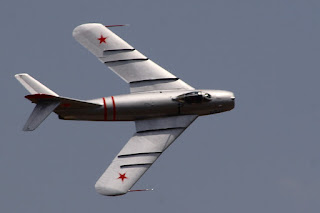In the course of a bit more than a century of aviation, the air has seen its share of the ancient tradition of deniable war. For example, the Condor Legion and Republican aircraft smugglers in Spain, the AVG in China, and the American volunteers of the Ethiopian air force. Probably the single most currently relevant example is one I have been postblogging: The clandestine participation of the Soviet 64th Fighter Aviation Corps in the Korean War. Clandestine, in that Soviet pilots flew aircraft with North Korean and Chinese insignia. Everyone knew what was going on. The secret existed only because it was in everyone's interest to pretend that it was secret. Although I do not find numbers for the personnel side of the Russian auxiliaries, the Wikipedia account says that there were 297 Sabres available in theatre facing 950 MiGs at the time of the 27 July 1953 ceasefire, flown by Chinese and North Korean as well as Soviet pilots.
So that's an occasion when the pilots of one nuclear power faced off against another under a convenient veil of ignorance and also with the pilots of one of the powers further insulated from the brute realities of great power politics by a collective action system in which there was some guarantee that, between a provoked American President and a final nuclear confrontation, there would interpose an angry Clement Attlee or avuncular Winston Churchill.
We have seen UN pilots playing the numbers game in the contemporary press, with a final claim of 792 MiG-15s shot down against 78 Sabres. A more recent estimate indicates a kill ratio closet to 1.3 to 1 in favour of American F-86s.This is, however, exclusive of other Allied jets and piston planes, and the point of the fighting was to drive off the B-29s bombing the Communist staging area on the Korean side of the Yalu around Sinanju, a name I cannot type without free associating.Which I probably should have repressed harder, since it turns out I was reminiscing about a yellowface performance..
It was the failure of the B-29, and not the F-86, which proved to be the crisis of the air war, since it was deemed necessary to maintain pressure on the airfields around Sinanju to prevent the Red Air Force from contesting air superiority over the battle front. The fact that the crisis did not eventuate does not change the fact that there was a bit of a "Fokker panic" going on in Korea in the fall of 1951. The USAF needed a new bomber, urgently. And while the aircraft in question was not ready in time for Korea, the USAF did get one, and that is the story on which this little technological appendix hangs.
Taken together I wanted to highlight this material as a very belated answer to the Audit of War thesis. This is as good an example as any of how the British headstart in producing combat aircraft for competitive air warfare is embodied in factory practice that is often invisible to top down views that focus on headline numbers like maximum speed. It is unfortunate that no-one takes Audit of War seriously, any more, but if anyone does still care, this is for you, business-first neo-liberal Thatcherites. Government enterprise does so work!
However, for today there is a newer and fresher take, the Fokker panic of the fall of 1951. Needless to say there are no actual Red jet hordes ready to push south and force UN tactical aviation, still dependent on P-51s and F4Us, from the battlefield. That is because Russian jet aircraft production is not, in fact, anywhere close to as far ahead of American as it was thought to be. The loss of time imposed by postwar budget cuts did not, in fact, lead to an unassailable Communist lead in aviation technology. (Not, to follow up on the lat paragraph, that government enterprise in the form of RAAF Meteors did any better.)
It is, however, probably true that air superiority over the forward edge of the battle area was decisive in wearing down the Red offensive and blunting it into an incomprehensible inertia, so that Seoul was never again encircled and captured, as some continued to fear would happen until surprisingly late in the conflict.
I hesitate to draw too close a parallel between a historical case and the current one, but if I were going to go down that road, it would be to point out that air superiority often hangs on the knife's edge of technological change, and that the crucial factors are not always obvious at the time. UN fighting forces at the front line came to be dependent on Forward Air Controllers in light liaison types, who made it possible for the UN air forces to fully develop their close air support potential. The Wikipedia article gives some insight into the process. the author taking the position that the Korean war lesson was not really assimilated at the time. Airborne FACs were abolished after the war, only to be revived in Vietnam. This might not be entirely fair, given the UN fear that Red air power would push south and roll back the air cover. FACs in liaisons could hardly expect to survive in an environment where MiG-15s have control of the air! This underlines the key role for which the B-57 was envisioned. In the absence of an absolutely dominant air-to-air capability, the only way to maintain UN air superiority over the front was to roll back the Red ability to conduct counter-air operations by day and night intruder attacks using radar-aimed bombing. Thanks to the very short range of the MiG, these attacks could be effective even if restricted to south of the Yalu, so that there would be no escalation resulting from attacks on Chinese soil. A longer-ranged MiG would have changed things again, and it is probably just as well for everyone that none showed up --perhaps intentionally so?




No comments:
Post a Comment